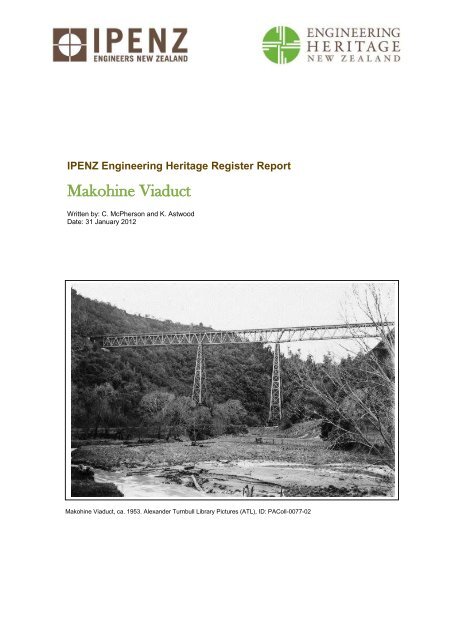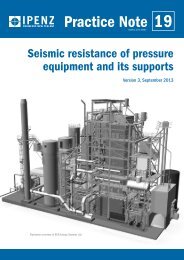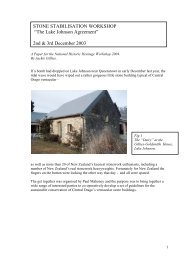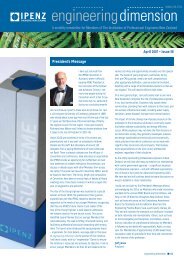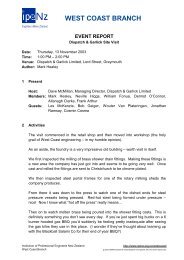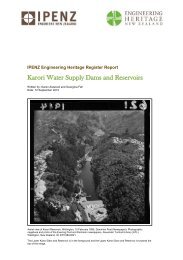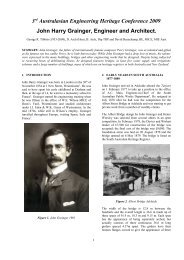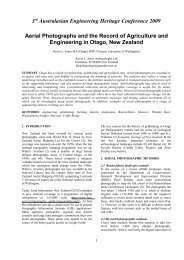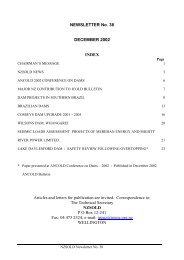Makohine Viaduct Registration Report 2012 (550 KB).pdf - ipenz
Makohine Viaduct Registration Report 2012 (550 KB).pdf - ipenz
Makohine Viaduct Registration Report 2012 (550 KB).pdf - ipenz
Create successful ePaper yourself
Turn your PDF publications into a flip-book with our unique Google optimized e-Paper software.
IPENZ Engineering Heritage Register <strong>Report</strong><br />
<strong>Makohine</strong> <strong>Viaduct</strong><br />
Written by: C. McPherson and K. Astwood<br />
Date: 31 January <strong>2012</strong><br />
<strong>Makohine</strong> <strong>Viaduct</strong>, ca. 1953. Alexander Turnbull Library Pictures (ATL), ID: PAColl-0077-02<br />
1
Contents<br />
A. General information ........................................................................................................... 3<br />
B. Description ......................................................................................................................... 5<br />
Summary ................................................................................................................................. 5<br />
Historical narrative .................................................................................................................... 7<br />
Social narrative ........................................................................................................................ 8<br />
Physical narrative ................................................................................................................... 16<br />
C. Assessment of significance ............................................................................................. 18<br />
D. Supporting information ...................................................................................................... 19<br />
List of supporting documents ................................................................................................... 19<br />
Bibliography ........................................................................................................................... 19<br />
IPENZ Engineering Heritage <strong>Report</strong> 2<br />
<strong>Makohine</strong> <strong>Viaduct</strong>
A. General information<br />
Name: <strong>Makohine</strong> <strong>Viaduct</strong><br />
Alternative names: <strong>Makohine</strong> Railway <strong>Viaduct</strong>; (former) Bridge 157 North Island<br />
Main Trunk; Bridge 120 North Island Main Trunk<br />
Location:<br />
North Island Main Trunk railway<br />
Near Ohingaiti<br />
Rangitikei<br />
Geo-reference: Latitude: -39.869 Longitude: 175.682 (centre of structure)<br />
Legal description: NZ Gazette 1898, p.1583<br />
Access information: The viaduct is best viewed from the valley below. There is a<br />
picnic/rest stop on State Highway 1 where traffic can stop safely. The North Island<br />
Main Trunk Railway also crosses over the structure.<br />
Location map courtesy of GoogleMaps<br />
<strong>Makohine</strong> <strong>Viaduct</strong><br />
IPENZ Engineering Heritage <strong>Report</strong> 3<br />
<strong>Makohine</strong> <strong>Viaduct</strong>
City/District Council: Rangitikei District Council<br />
IPENZ category: Engineering Work<br />
IPENZ subcategory: Rail Transportation<br />
IPENZ Engineering Heritage number: 2175<br />
Date registered: 24 April <strong>2012</strong><br />
Other IPENZ recognition: Plaque: Engineering Heritage (unveiled August 2008,<br />
installed March 2011)<br />
Other heritage recognition:<br />
New Zealand Historic Places Trust: Category 1 historic place (Register no.<br />
32)<br />
Local Authority District Plan: Rangitikei District Plan Proposed 28 October<br />
2010. No. H1 in Schedule C3- Historic Heritage (Last Amended: 28 Oct<br />
2010)<br />
IPENZ Engineering Heritage <strong>Report</strong> 4<br />
<strong>Makohine</strong> <strong>Viaduct</strong>
B. Description<br />
Summary<br />
The <strong>Makohine</strong> <strong>Viaduct</strong> is an impressive engineering achievement. Its was one of<br />
many viaducts designed by engineer Peter Seton Hay (1852/53-1907) in the central<br />
part of the North Island Main Trunk (NIMT) railway. The <strong>Makohine</strong> <strong>Viaduct</strong> overcame<br />
the first major natural obstacle to the NIMT‟s completion, spanning a bush-clad<br />
gorge, approximately two kilometres (km) south of Ohingaiti.<br />
In 1870, earnest planning began for a railway to connect Auckland and Wellington,<br />
the two main centres in the North Island. However, the topography of the central<br />
North Island caused a headache for surveyors and Public Works Department (PWD)<br />
engineers trying to finalize a route. In 1887, the railheads stood just south of Te Kuiti<br />
and at Marton. Conquering the difficult terrain would involve various earthworks and<br />
tunnels, bridges and viaducts.<br />
The <strong>Makohine</strong> <strong>Viaduct</strong> was constructed across the 228 metres (m) of bush-clad<br />
<strong>Makohine</strong> Stream valley. Built between 1896 and 1902, the <strong>Makohine</strong> <strong>Viaduct</strong> project<br />
suffered numerous delays due to soil conditions, flooding, inclement weather, and a<br />
steel strike in England. However, the experienced engineers and builders involved in<br />
its construction, such as Alexander Buchan (1845?-1905), George Leslie Cook<br />
(1851-1942), Samuel John Harding (1861-1948) and Walter Sneddon (1837-1925),<br />
had to persevere, under considerable pressure from the public and the Government,<br />
in order for the NIMT to progress.<br />
The steel was eventually fabricated in the PWD‟s nearby Mangaonoho workshops.<br />
These were located on Ironworks Road and fabricated the steel for many NIMT<br />
construction era bridges which followed the <strong>Makohine</strong> <strong>Viaduct</strong>. The <strong>Makohine</strong> <strong>Viaduct</strong><br />
was under the co-operative system. This was the one of the first major PWD projects<br />
in New Zealand to be started under a directive to favour this approach to<br />
construction, and it was subsequently used on much of the rest of the NIMT.<br />
At 72 metres (m) high the <strong>Makohine</strong> <strong>Viaduct</strong> was, when completed, the tallest viaduct<br />
in New Zealand. Subsequently overtaken by its NIMT younger sibling, the Makatote<br />
<strong>Viaduct</strong>, for several decades the <strong>Makohine</strong> <strong>Viaduct</strong> was the second highest railway<br />
bridge in New Zealand. The structure has not been significantly modified since<br />
construction, although it has been upgraded and strengthened in conjunction with<br />
IPENZ Engineering Heritage <strong>Report</strong> 5<br />
<strong>Makohine</strong> <strong>Viaduct</strong>
changes to NIMT operational requirements, such as circa 1932 when heavier<br />
locomotives were introduced, and around 1984 in preparation for the railway‟s<br />
electrification.<br />
IPENZ Engineering Heritage <strong>Report</strong> 6<br />
<strong>Makohine</strong> <strong>Viaduct</strong>
Historical narrative<br />
The North Island Main Trunk (NIMT) railway‟s completion in late 1908 is arguably the<br />
most significant example of New Zealand engineering success during the late 19th<br />
and early 20th century. 1<br />
In 1863, with the railway from Auckland to Drury, preliminary work began on what<br />
would evolve into the arterial rail route through the North Island. 2 In 1870 the Public<br />
Works Department (PWD) was established, and under this department the direct rail<br />
link between the North Island‟s two main centres, Auckland and Wellington, was to<br />
become a reality, albeit over a prolonged period. Progress from Auckland coincided<br />
with construction north from Wellington. By 1880 the railheads approached Te<br />
Awamutu and Marton. The approximate 322 kilometre (km) section between these<br />
towns crossed the King Country and the central plateau. 3 This section proved the<br />
most problematic to traverse with a railway because of its terrain which included<br />
frequent deep valleys, unstable grounds, and the numerous rivers crisscrossing the<br />
area. This contributed to the NIMT not being completed until decades later. 4<br />
Construction work towards Ohingaiti began in 1892. 5 By March 1894 the formations<br />
had progressed up to the first of many significant obstacles in the central North<br />
Island; the <strong>Makohine</strong> Stream. 6 Therefore, Peter Seton Hay (1852/53-1907) who was<br />
called upon to developed plans for a large viaduct to traverse the stream valley,<br />
proposed a steel trestle bridge. Alternatives to this viaduct, which would be the<br />
highest in New Zealand at that point, had been considered. However, these would<br />
require extensive earthworks, have a steeper gradient, and include tighter curvature<br />
in the tracks, all of which were undesirable. Therefore, Hay‟s viaduct design was<br />
settled upon and preparatory site construction work eventually began in mid-1896. 7<br />
1 Roy Sinclair, Journeying with Railways in New Zealand, Auckland, 1997, p. 253<br />
2 Roy Sinclair, Rail: The great New Zealand Adventure, Wellington, 1987, p. 16<br />
3 Neill Atkinson, 'Railways - Main trunk lines', Te Ara - the Encyclopedia of New Zealand, URL:<br />
www.TeAra.govt.nz/en/railways/2 (updated 30 June 2011)<br />
4 Robin Bromby, Rails that Built a Nation: An encyclopedia of New Zealand railways, Wellington, 2003, p.21; A. L. R.<br />
Merrifield, „New Zealand‟s North Island main trunk railway: 1870-1908,‟ Proceedings of the Institution of Civil<br />
Engineers, Engineering History and Heritage, Vol. 162:4 (2009), p.207<br />
5 Bill Pierre, North Island Main Trunk: An illustrated history, Auckland, 1981, p.50<br />
6 R. J. Meyer and P. J. Moyes, „The Rise and Fall of the <strong>Makohine</strong> Tunnel,‟ New Zealand Railway Observer,<br />
Vol.42:183 (Spring 1985), p.90<br />
7 David Leitch, Railways of New Zealand, Auckland, 1972, p. 55; <strong>Makohine</strong> <strong>Viaduct</strong> – General Evaluation and<br />
Elevation of Piers – [Unnumbered]. Archives New Zealand (ANZ), AADX W3774 15/17207. This drawing is Sheet 1<br />
of PWD 17207, signed and dated P. S. Hay 29.7.95<br />
IPENZ Engineering Heritage <strong>Report</strong> 7<br />
<strong>Makohine</strong> <strong>Viaduct</strong>
A gifted mathematician, Hay joined the PWD as an engineering cadet in 1875, and<br />
was soon involved in surveys and railway construction across New Zealand.<br />
Progressing through the ranks of the PWD, Hay became Superintending Engineer in<br />
1896 and was often asked to assist the Engineer-in-Chief with any tricky problems. 8<br />
Hay designed the <strong>Makohine</strong> <strong>Viaduct</strong>, and also five other viaducts in the final stage of<br />
NIMT‟s construction: Mangaweka, Hapuawhenua, Taonui, Manganui-a-te-ao and<br />
Makatoke <strong>Viaduct</strong>s. 9 His work on the <strong>Makohine</strong> <strong>Viaduct</strong> was duly acknowledged by<br />
the Minister of Public Works, William Hall-Jones (1851-1936), at the <strong>Makohine</strong><br />
<strong>Viaduct</strong>‟s opening ceremony. Hall-Jones paid “high tribute to Mr P. S. Hay, the<br />
Engineer of the Public Works Department, for his skill in designing such a<br />
structure.” 10 Soon after the completion of the <strong>Makohine</strong> <strong>Viaduct</strong>, Hay became the<br />
PWD Engineer-in-Chief, succeeding William Henry Hales (1830-1909). However, this<br />
lead role was short-lived because Hay died of pneumonia in 1907, a disease which is<br />
said to have developed as a result of exposure while he was inspecting NIMT<br />
works. 11<br />
Tenders for the construction of the <strong>Makohine</strong> <strong>Viaduct</strong> had been called for in February<br />
1896. The lowest tender was in excess of what the Government had expected, which<br />
was a motivating factor for the PWD putting the work under co-operative contract. 12<br />
This concept was first introduced in New Zealand when Richard John Seddon (1845-<br />
1906) was Minister of Public Works. 13 The co-operative system sectioned the railway<br />
into small parts, which groups of six to 12 men would complete, using materials and<br />
equipment provided by the PWD, and supervised by an elected headman. 14 An<br />
advantage of the co-operative system was that the PWD had tighter control over the<br />
quality of work and the work was generally completed comparatively cheaply. In the<br />
early 1890s contractors were still widely used for constructing government buildings<br />
and structures. However, in 1896 “a departmental circular reminded all engineers that<br />
wherever practicable works were to be carried out on the co-operative principle.” 15<br />
Therefore, the <strong>Makohine</strong> <strong>Viaduct</strong> was a test case for the co-operative system‟s<br />
8 Peter Lowe, „Hay, Peter Seton, 1852/3-1907, Civil engineer, Public Servant,‟ Te Ara- the Encyclopedia of New<br />
Zealand- Dictionary of New Zealand Biography, URL: www.teara.govt.nz/en/biographies/2h24/1 (updated 1<br />
September 2010)<br />
9 Pierre, p.36<br />
10 Evening Post, 17 June 1902, p.5<br />
11 Lowe; F. W. Furkert, Early New Zealand Engineers, Wellington, 1953, p.185<br />
12 F. K. Roberts, A Compendium of Railway Construction, Part Two: North Island Main Trunk, Wellington, 1990, p.46<br />
13 Pierre, p.40<br />
14 Geoffrey Thornton, Bridging the Gap: Early Bridges in New Zealand 1830-1939, Auckland, 2001, p. 146<br />
15 Rosslyn Noonan, By Design: A brief history of the Public Works Department Ministry of Works, 1870-1970,<br />
Wellington, 1975, p.78<br />
IPENZ Engineering Heritage <strong>Report</strong> 8<br />
<strong>Makohine</strong> <strong>Viaduct</strong>
effectiveness, as it was one of the first major structures to be initiated under this<br />
directive nationally. 16<br />
However, circumstances out of the workforce‟s control plagued the <strong>Makohine</strong> <strong>Viaduct</strong><br />
construction project. Adverse weather conditions caused work to stop in the early<br />
constructions period. Heavy rain affected the unstable papa-origin soil, impeding the<br />
pier foundations‟ construction in 1897. This, combined with preparation of the<br />
concrete for the footings being delayed because of flooding in the gravel pit, work on<br />
the pier footings did not begin again until the following year. 17<br />
In 1896 the Mangaonoho Public Works shop was established, near the <strong>Makohine</strong><br />
site, to fabricate the steel for the <strong>Makohine</strong> <strong>Viaduct</strong>. 18 However, delays were caused<br />
through manufacturing plant not being forthcoming because of British steel strikes. 19<br />
Once fully operational, in late 1898 and throughout 1899 the workshops ran on a 16-<br />
hour a day system to try and catch-up with steel fabrication. Electric lights were used<br />
to light the track and the workshop so work could continue into the night. 20 In this way<br />
all the steelwork for the <strong>Makohine</strong> <strong>Viaduct</strong> was ready in 1900 and pier construction<br />
was begun. 21 It has been said that the “resources and inventiveness of New Zealand<br />
engineers and workmen were evoked, tested and developed by challenges of this<br />
sort.” 22<br />
With pressure mounting on the Government to complete the NIMT‟s drawn out<br />
construction, the <strong>Makohine</strong> <strong>Viaduct</strong>‟s completion became a priority because it was<br />
seen as the main hurdle to progressing the works. Fortunately, construction was only<br />
held-up for a prolonged period once more, in 1901 due to unfavourable weather. 23<br />
The public all over New Zealand were kept well-informed of the structure‟s progress<br />
with regular updates in the newspapers from 1896 until its completion.<br />
16 Noonan, pp.78-79; Pierre, p.40<br />
17 Pierre, p.56<br />
18 The Mangaonoho workshops also fabricated steel for all subsequent original NIMT viaducts, with the exception of<br />
the Makatote <strong>Viaduct</strong>. Meyer, p.90<br />
19 Roberts, p.46<br />
20 Pierre, p.56; Thornton, p.146<br />
21 Pierre, p.56<br />
22 Gordon Troup (ed.), Steel Roads of New Zealand: An illustrated survey, Wellington, 1973, p.145<br />
23 Roberts, p.46<br />
IPENZ Engineering Heritage <strong>Report</strong> 9<br />
<strong>Makohine</strong> <strong>Viaduct</strong>
The general labourers employed as part of the co-operative system were overseen by<br />
a hierarchy of Government engineers and experienced contractors. In the especially<br />
trying early stages of the build between 1896 and 1898, Samuel John Harding (1861-<br />
1948) was involved with the project in his capacity as Assistant Engineer to<br />
Hunterville. After being transferred to work on the railway south from Blenheim,<br />
Harding was to return to the NIMT in 1903, this time as the Local Engineer at<br />
Taihape. 24 In this senior role he is credited with being the creator of the section<br />
between Taihape and Waiouru, and the success of components such as the<br />
Turangarere Horseshoe. 25<br />
After the difficult beginning to the project, the bulk of the <strong>Makohine</strong> <strong>Viaduct</strong>‟s on-site<br />
construction seems to have been under the supervision Walter Sneddon (1837-1925)<br />
who was variously described as “overseer to the works”, “mechanical engineer”, and<br />
“engineer in charge” at the <strong>Makohine</strong> <strong>Viaduct</strong>. 26 Sneddon, who immigrated to New<br />
24 Furkert, p.182; Pierre, p.63<br />
25 Furkert, p.182; Pierre, p.66<br />
26 „<strong>Makohine</strong> <strong>Viaduct</strong> Works,‟ Wanganui Chronicle, 25 October 1898, p.2; Evening Post, 19 February 1901, p.6;<br />
Marlborough Express, 5 November 1901, p.2<br />
Figure 1: View of the <strong>Makohine</strong><br />
<strong>Viaduct</strong> under construction, ca 1900.<br />
Godber, Albert Percy, 1875-1949:<br />
Collection of albums, prints and<br />
negatives, ATL, APG-0021-1/2-G<br />
IPENZ Engineering Heritage <strong>Report</strong> 10<br />
<strong>Makohine</strong> <strong>Viaduct</strong>
Zealand in the 1860s, had been employed with prominent Christchurch construction<br />
firm, J and A Anderson, and gained important experience in construction contracting.<br />
While in the employ of Andersons, Sneddon headed construction projects such as the<br />
Beaumount Bridge (completed 1887) across the Clutha River, and then the first part<br />
of the construction of the nearby Miller‟s Flat Bridge (1897-99). 27 However, from mid-<br />
1898 Sneddon was engaged on the <strong>Makohine</strong> <strong>Viaduct</strong> project and moved to the<br />
North Island as a result. 28 At the time of the <strong>Makohine</strong> <strong>Viaduct</strong>‟s construction<br />
Sneddon was said to be “the most experienced iron bridge builder in New Zealand.” 29<br />
Sneddon also fulfilled similar roles at other nearby structures, namely the Mangaweka<br />
<strong>Viaduct</strong> and Toitoi Bridge. 30 Alexander Buchan (1845?-1905), who was the<br />
Government overseer at the <strong>Makohine</strong> <strong>Viaduct</strong> is also mentioned as ably assisting<br />
Sneddon. 31<br />
From 1898 the Resident Engineer to Hunterville was George Leslie Cook (1851-<br />
1942). He was ultimately responsible to his national office PWD superiors for the<br />
progress of the works in the <strong>Makohine</strong> section and subsequent works further north. 32<br />
Cook also had a wealth of experience, and being put in charge is perhaps reflective<br />
of the importance completing the <strong>Makohine</strong> <strong>Viaduct</strong>. Cook who had risen through the<br />
ranks of the PWD, began as a cadet in 1872. Prior to his work on the NIMT he had<br />
been the Resident Engineer on the Otago Central Railway, and in Wellington, before<br />
being placed in charge of the Eketahuna to Woodville Railway in the early 1890s. 33<br />
The <strong>Makohine</strong> <strong>Viaduct</strong>‟s eventual completion was marked with a celebration on 17<br />
June 1902. The long project‟s completion was significant because it meant the NIMT<br />
was an important step closer to realisation. The Evening Post reported that during the<br />
official opening Hall-Jones praised the construction and design of the viaduct, stating:<br />
…there was no doubt they [the engineers and construction team] had been<br />
engaged upon a work the like of which did not exist in the Southern<br />
Hemisphere, and he had no hesitation in saying that there had never been a<br />
better piece of work turned out in any part of the world. 34<br />
27 „Mr Walter Sneddon,‟ The Press, 28 March 1925. M. Holmes to K. Astwood, 9 June 2011. IPENZ<br />
28 Otago Witness, 19 May 1898, p.30<br />
29 „Mr A. E. Remington at Hunterville,‟ Wanganui Chronicle, 18 March 1899, p.3<br />
30 „Mr Walter Sneddon‟<br />
31 Manawatu Times, 3 November 1903, p.2; „Obituary,‟ Wanganui Herald, 25 April 1905, p.5; „Our Mangaweka Man,‟<br />
Manawatu Times, 18 February 1904, p.3<br />
32 Pierre, pp.64-66<br />
33 Furkert, pp.143-44<br />
34 Evening Post, 17 June 1902, p.5<br />
IPENZ Engineering Heritage <strong>Report</strong> 11<br />
<strong>Makohine</strong> <strong>Viaduct</strong>
No doubt the hard-pressed Mangaonoho workshops employees were pleased with<br />
this praise, but perhaps more happy that their reward was a day off of work. Buchan,<br />
Cook, and Sneddon were also lauded enthusiastically in the lead-up to, and at, the<br />
opening ceremony. 35<br />
The <strong>Makohine</strong> <strong>Viaduct</strong>‟s completion combated a major obstacle and allowed for the<br />
NIMT‟s construction north from Wellington to push forward. When it was eventually<br />
completed in 1908, the NIMT became a crucial part of the New Zealand transport<br />
system. The railway quickly became the main arterial route through the North Island,<br />
having an important social and economic impact. 36<br />
The NIMT has been the subject of much literature and admired as an engineering<br />
achievement. Official heritage recognition has come in the form of the New Zealand<br />
Historic Places Trust (NZHPT) registration of the railway‟s components, such as the<br />
<strong>Makohine</strong> <strong>Viaduct</strong> „s1985 Category I historic place registration. In 2009 the <strong>Makohine</strong><br />
<strong>Viaduct</strong> was also included in the NZHPT‟s NIMT Historic Area. 37 In 2011, IPENZ<br />
unveiled a plaque at the <strong>Makohine</strong> <strong>Viaduct</strong>, site to commemorate its engineering<br />
significance. 38<br />
35 Examples include: „The <strong>Makohine</strong> <strong>Viaduct</strong>,‟ Wairarapa Daily Times, 10 June 1902, p.4; „A Trip to the <strong>Makohine</strong><br />
<strong>Viaduct</strong>,‟ Taranaki Herald, 13 June 1902, p.1; „Evening Post, 17 June 1902, p.5<br />
36 Pierre, p.139<br />
37 <strong>Makohine</strong> <strong>Viaduct</strong>, New Zealand Historic Places Trust Register,<br />
www.historic.org.nz/TheRegister/RegisterSearch/RegisterResults.aspx?RID=32 (accessed 28 November 2011);<br />
North Island Main Trunk (NIMT) Historic Area, New Zealand Historic Places Trust Register,<br />
www.historic.org.nz/TheRegister/RegisterSearch/RegisterResults.aspx?RID=7793 (accessed 28 November 2011)<br />
38 „Commemorating a Railway Icon,‟ Engineering Dimension, Iss.103 (May 2011), p.5. URL:<br />
www.<strong>ipenz</strong>.org.nz/<strong>ipenz</strong>/publications/dimension/2011/Dim_May11.<strong>pdf</strong><br />
IPENZ Engineering Heritage <strong>Report</strong> 12<br />
<strong>Makohine</strong> <strong>Viaduct</strong>
Social narrative<br />
39 Bromby, p.21<br />
At the height of construction, between 1906 and 1908, the NIMT‟s workforce<br />
consisted of around 2,500 people. 39 As the NIMT building progressed temporary work<br />
camps were established close by construction sites, moving on as the work did.<br />
However, whenever there was a major component in the railway that took several<br />
years to build, such as large viaducts, semi-permanent or permanent facilities usually<br />
coincided, such as shops and even schools. 40<br />
Unusually, the <strong>Makohine</strong> camp does not seem to have evolved into a settlement of<br />
any particular permanence, scale, or longevity after the viaduct construction was<br />
complete. However, there were workers who settled for a prolonged period at the<br />
<strong>Makohine</strong> construction site. In 1898, for example, it was recorded that many workers<br />
with families were squatting on the Railway Reserve, a practice that was allowed to<br />
continue while construction was underway. 41 One of these men was James<br />
McDonnell who worked at the Mangaonoho workshops. By 1902 he had set up a<br />
home, fenced it off, and was applying to the Government to lease the land. 42<br />
However, it is generally thought that the lengthy duration of irregular construction at<br />
the <strong>Makohine</strong> <strong>Viaduct</strong> prohibited the formation of an enduring settlement founded as<br />
a direct result of the railway work. 43 At various points in the construction the estimated<br />
number of workers seems to have fluctuated between about 30 to 300 people<br />
specifically working on the <strong>Makohine</strong> <strong>Viaduct</strong> project. 44<br />
Work upon the railway was hard and the frontier nature of living conditions was not<br />
the only hardship faced by the <strong>Makohine</strong> <strong>Viaduct</strong> workers. There are inherent<br />
dangers associated with constructing large engineering structures and the <strong>Makohine</strong><br />
<strong>Viaduct</strong> was no exception. 45 During the viaduct‟s construction, fatalities did happen;<br />
on 18 October 1900 it was reported that “Robert Lyons, one of the men working on<br />
40 Kate Hill, Raurimu Frontier Town 1900-1925: A Social Archaeological Perspective. Auckland, 1999, p. 19<br />
41 H. Lundius to Commissioner of Crown Lands, 2 July 1898; Commissioner of Crown Lands to H. Lunius, 15 July<br />
1898. ANZ, AFIE 619 137/13/120 pt1<br />
42 James McDonnell to A. W. Hogg, 6 December 1902. ANZ, AFIE 619 137/13/120 pt1<br />
43 Thornton, p.146<br />
44 „The <strong>Makohine</strong> <strong>Viaduct</strong>,‟ Star, 12 May 1897, p.1; „The <strong>Makohine</strong> <strong>Viaduct</strong>,‟ Manawatu Herald, 7 December 1897, p.3<br />
45 Atkinson. Although not directly reletaed to the construction of the <strong>Makohine</strong> <strong>Viaduct</strong> it should be noted that in 1893<br />
prepatory works for the tunnel which opened onto the viaduct destablilsed the hillside, causing a massive landslide.<br />
This buried a mother, her three children and neice, and they died as a result. „The Mokohine [sic] Fatality,‟ Wanganui<br />
Chronicle, 15 November 1893, p.2<br />
IPENZ Engineering Heritage <strong>Report</strong> 13<br />
<strong>Makohine</strong> <strong>Viaduct</strong>
the principal pier, was killed by falling from the scaffolding, a height of about 80<br />
feet.” 46 There was reportedly one other on-site fatality. 47<br />
The completion of the <strong>Makohine</strong> <strong>Viaduct</strong>, and later the entirety of the NIMT,<br />
benefitted New Zealand economically and had a substantial social impact. Travel was<br />
improved between the North Island‟s two major centres, cutting down travel times and<br />
assisting with communications nationwide. Auxiliary roads, telegraph wires and<br />
settlements developed because of the railway. 48<br />
The <strong>Makohine</strong> <strong>Viaduct</strong> was acknowledged as a landmark structure from the time of its<br />
completion. 49 This was enhanced as road traffic increased because there was a good<br />
view of the structure for traffic passing on the main highway. The Scenic Reserve in<br />
the gully north of the viaduct formed a dramatic and picturesque bush backdrop. This<br />
Reserve was established just prior to the NIMT‟s completion, and was preserved<br />
because the land, not suitable for settlement, had a good selection of native trees<br />
which inhibited erosion. 50 In the mid-twentieth century the original road was<br />
straightened south of the viaduct and the land in between became a popular road-<br />
46 „Accidents and Fatalities,‟ Evening Post,18 October 1900, p.5<br />
47 „Our Mangaweka Man‟<br />
48 Hill, p.3.<br />
Figure 2: <strong>Makohine</strong> <strong>Viaduct</strong> Workers, between 1898-1902. Cameron, R A: Photographs of Ohingaiti, ATL,<br />
ID:1/2-094227-F.<br />
49 „Evening Post, 17 June 1902, p.5<br />
50 Reserve for Inspection and <strong>Report</strong> – Sc. Reserve <strong>Makohine</strong> S.R., 1977. ANZ, AFIE 619 137/13/120 pt1<br />
IPENZ Engineering Heritage <strong>Report</strong> 14<br />
<strong>Makohine</strong> <strong>Viaduct</strong>
side picnic area and rest stop. 51 Recently another realignment of State Highway 1<br />
was completed, but the rest stop, which features the <strong>Makohine</strong> <strong>Viaduct</strong> IPENZ<br />
Engineering Heritage plaque with the viaduct in view behind, is still accessible to the<br />
public. 52<br />
51 Copy of plan with memo 12/2/62; <strong>Makohine</strong> Deviation Picnic Area land to be taken [n.d.], ANZ, AATC 5114 W3457<br />
152/8/1/5/11<br />
52 Terry Karatau, „Project to save lives,‟ Manawatu Standard, 22 March 2011. URL: www.stuff.co.nz/manawatu-<br />
standard/news/rangitikei-mail/4795553/Project-to-save-lives (accessed 6 December 2011)<br />
IPENZ Engineering Heritage <strong>Report</strong> 15<br />
<strong>Makohine</strong> <strong>Viaduct</strong>
53 Troup, p.300<br />
54 Thornton, p. 145<br />
55 Bromby, p. 132<br />
56 Pierre, p.53<br />
57 Ibid., p.35<br />
58 Merrifield, p.214<br />
Physical narrative<br />
When the NIMT was completed, the <strong>Makohine</strong> <strong>Viaduct</strong> was the highest viaduct both<br />
on the railway, and nationally, at 72 m high. 53 It has concrete abutments and footings.<br />
The superstructure consists of two steel trestle piers, two 75 m steel Warren trusses<br />
and a central 53 m truss. 54 The viaduct is 228 m long. The 1,272 tonnes of steel used<br />
in the <strong>Makohine</strong> <strong>Viaduct</strong>‟s construction was acquired from England and fabricated<br />
close to the viaduct site. 55<br />
Figure 3: View of the <strong>Makohine</strong> <strong>Viaduct</strong> under construction, ca 1900. Godber, Albert Percy, 1875-1949:<br />
Collection of albums, prints and negatives, ATL, ID: APG-0055-1/2-G<br />
It has been noted that t the <strong>Makohine</strong> <strong>Viaduct</strong>‟s spans were longer than those of its<br />
NIMT construction-era counterparts. 56 Having relatively long spans meant costly<br />
additional piers were avoided in a valley that became known as a difficult place to<br />
create satisfactory footings. 57 The form of the viaduct is unique in New Zealand: “The<br />
central Warren truss is cantilevered across two towers, each carrying a simply<br />
supported similar truss span back to the abutments.” 58 The viaduct was also<br />
IPENZ Engineering Heritage <strong>Report</strong> 16<br />
<strong>Makohine</strong> <strong>Viaduct</strong>
59 Roberts, p.46<br />
individual in its construction method because framing was used to support the<br />
cantilevered spans as they were constructed. For the other final stage NIMT viaducts,<br />
prefabricated trusses and girders were launched into place. 59<br />
Since the viaduct‟s completion in 1902 it has been modified on several occasions to<br />
make it compatible with the NIMT‟s changing operational needs. The viaduct was first<br />
strengthened around 1932 to allow heavier locomotives to safely cross. This work<br />
involved adding intermediate vertical members to the Warren trusses of the two main<br />
spans. 60 The viaduct was again strengthened in the early 1980s to prepare for the<br />
NIMT‟s electrification, which entailed replacing the smaller end spans. 61 It also<br />
included “replacing wooden way-beams directly under the track with steel, and<br />
providing linkages to transmit traction and braking forces into the main structure.” 62<br />
During this period the tunnel immediately adjacent to the viaduct was opened into a<br />
cutting, or daylighted, and the curve of the track on the eastern side opposite was<br />
also eased. 63<br />
Key physical dates<br />
Mid-1896 Site preparation begins<br />
1897 Excavations continue (with delays) and foundations and<br />
footings begins<br />
1900 Construction of piers<br />
1901 Construction of girders<br />
1902 <strong>Viaduct</strong> complete<br />
circa 1932 Strengthened<br />
circa 1934 Strengthened<br />
1982-circa 1984 Strengthened<br />
60 „Electric Welding,‟ Evening Post, 7 August 1937, p.11; Pierre, p.156<br />
61 „First step in Main Trunk Change,‟ Auckland Star, 18 January 1982. ANZ, AAEB W3438 56/22/247/10 pt4; „Main<br />
Trunk to close again,‟ Wanganui Herald, 18 April 1984. ANZ, AAEB W3438 56/22/247/10 pt5<br />
62 R. Merrifield to K. Astwood, 22 December 2011. IPENZ<br />
63 „Main Trunk Electrification Progress,‟ New Zealand Railway Observer, Vol.42:181 (Autumn 1985), p.27<br />
IPENZ Engineering Heritage <strong>Report</strong> 17<br />
<strong>Makohine</strong> <strong>Viaduct</strong>
C. Assessment of significance<br />
The <strong>Makohine</strong> <strong>Viaduct</strong> overcame the first significant physical obstruction in the final<br />
phase of the North Island Main Trunk (NIMT) railway‟s construction and is an<br />
outstanding engineering feat in itself. As the highest New Zealand viaduct at the time<br />
of its construction in 1902, the <strong>Makohine</strong> <strong>Viaduct</strong> is a lasting tribute to Peter Seton<br />
Hay‟s engineering achievements and initiative. It is also a testimony to the skill and<br />
management of numerous other engineers involved in the project, such as Buchan,<br />
Cook, Harding, and Sneddon.<br />
Physically impressive, the <strong>Makohine</strong> <strong>Viaduct</strong> also has further importance within the<br />
socially and economically significant NIMT, and was one of the first major test cases<br />
under a Public Works Department 1890s directive to favour the co-operative<br />
construction system. Therefore, the <strong>Makohine</strong> <strong>Viaduct</strong> set the construction framework<br />
for completing the majority of the remaining NMIT structures.<br />
Heralded as an engineering triumph upon completion, the <strong>Makohine</strong> <strong>Viaduct</strong> has<br />
continued to be a NMIT icon and a key landmark in the central North Island.<br />
Therefore, the <strong>Makohine</strong> <strong>Viaduct</strong> is of sufficient engineering heritage significance to<br />
warrant inclusion within the IPENZ Engineering Heritage Register.<br />
IPENZ Engineering Heritage <strong>Report</strong> 18<br />
<strong>Makohine</strong> <strong>Viaduct</strong>
D. Supporting information<br />
List of supporting information<br />
Link to: Commemorating a Railway Icon, Engineering Dimension, Iss.103 (May<br />
2011), p.5. URL:<br />
://www.<strong>ipenz</strong>.org.nz/<strong>ipenz</strong>/publications/dimension/2011/Dim_May11.<strong>pdf</strong> (accessed 6<br />
December 2011)<br />
Link to: <strong>Makohine</strong> <strong>Viaduct</strong>, New Zealand Historic Places Trust Register,<br />
www.historic.org.nz/TheRegister/RegisterSearch/RegisterResults.aspx?RID=32<br />
(accessed 28 November 2011)<br />
Link to: North Island Main Trunk (NIMT) Historic Area, New Zealand Historic Places<br />
Trust Register,<br />
www.historic.org.nz/TheRegister/RegisterSearch/RegisterResults.aspx?RID=7793<br />
(accessed 28 November 2011)<br />
Bibliography<br />
Archival Sources<br />
Available from Archives New Zealand, Wellington<br />
<strong>Makohine</strong> Deviation, AATC 5114 W3457 152/8/1/5/11<br />
<strong>Makohine</strong> Scenic Reserve – Tiriraukawa S.D. [Survey District] Pts ]Parts]<br />
Pawerawera No.s 1 & 2 Blks [Blocks] XVI Pts 11 & 12 – Town of <strong>Makohine</strong> Blk<br />
[Block] XVI, 1897-1907, AFIE 619 137/13/120 pt1<br />
<strong>Makohine</strong> <strong>Viaduct</strong> – General Evaluation Plan and Elevation of Piers – [Unnumbered],<br />
AADX W3774 15/17207<br />
NZ Railway: Newspaper clippings – Electrification of Railways, 1980-1982, AAEB<br />
W3438 56/22/247/10 pt4<br />
NZ Railway: Newspaper clippings – Electrification of Railways, 1982-1984, AAEB<br />
W3438 56/22/247/10 pt5<br />
IPENZ Engineering Heritage <strong>Report</strong> 19<br />
<strong>Makohine</strong> <strong>Viaduct</strong>
Published Sources<br />
New Zealand Railway Observer, Vol.42:181 (Autumn 1985), Vol.42:183 (Spring<br />
1985)<br />
Bromby, Robin, Rails that Built a Nation: An encyclopedia of New Zealand railways,<br />
Wellington, 2003<br />
Hill, Kate, Raurimu Frontier Town 1900-1925: A Social Archaeological Perspective.<br />
Auckland, 1999<br />
Furkert, F. W., Early New Zealand Engineers, Wellington, 1953<br />
Leitch, David, Railways of New Zealand, Auckland, 1972<br />
Merrifield, A. L. R., „New Zealand‟s North Island main trunk railway: 1870-1908,‟<br />
Proceedings of the Institution of Civil Engineers, Engineering History and Heritage,<br />
Vol. 162:4 (2009), pp.207-19<br />
Noonan, Rosslyn, By Design: A brief history of the Public Works Department Ministry<br />
of Works, 1870-1970, Wellington, 1975<br />
Pierre, Bill, North Island Main Trunk: An illustrated history, Auckland, 1981<br />
Roberts, F. K., A Compendium of Railway Construction, Part Two: North Island Main<br />
Trunk, Wellington, 1990<br />
Sinclair, Roy, Journeying with Railways in New Zealand, Auckland, 1997<br />
Sinclair, Roy, Rail: The great New Zealand adventure, Auckland, 1987<br />
Thornton, Geoffrey, Bridging the Gap: Early Bridges in New Zealand 1830-1939,<br />
Auckland, 2001<br />
Troup, Gordon (ed.), Steel Roads of New Zealand: An illustrated survey, Wellington,<br />
1973<br />
IPENZ Engineering Heritage <strong>Report</strong> 20<br />
<strong>Makohine</strong> <strong>Viaduct</strong>
Electronic Sources<br />
Atkinson, Neill, 'Railways - Main trunk lines', Te Ara - the Encyclopedia of New<br />
Zealand, URL: www.TeAra.govt.nz/en/railways/2 (updated 30 June 2011)<br />
Karatau, Terry, „Project to save lives,‟ Manawatu Standard, 22 March 2011. URL:<br />
www.stuff.co.nz/manawatu-standard/news/rangitikei-mail/4795553/Project-to-save-<br />
lives (accessed 6 December 2011)<br />
Lowe, Peter, „Hay, Peter Seton, 1852/3-1907, Civil engineer, Public Servant‟, Te Ara-<br />
the Encyclopedia of New Zealand - Dictionary of New Zealand Biography, URL:<br />
www.teara.govt.nz/en/biographies/2h24/1 (updated 1 September 2010)<br />
Phillips, Jock, „Bridges and tunnels- Building bridges and tunnels‟, Te Ara- the<br />
Encyclopedia of New Zealand, URL: www.teara.govt.nz/en/bridges-and-tunnels/2<br />
(updated 26 November 2010)<br />
Available from Papers Past, paperspast.natlib.govt.nz/cgi-bin/paperspast:<br />
Evening Post, 18 October 1900, 19 February 1901, 17 June 1902, 7 August 1937<br />
Manawatu Times, 7 December 1897, 3 November 1903, 18 February 1904<br />
Marlborough Express, 5 November 1901<br />
Otago Witness, 19 May 1898<br />
Star, 12 May 1897<br />
Taranaki Herald, 13 June 1902<br />
Wairarapa Daily Times, 10 June 1902<br />
Wanganui Chronicle, 28 October 1898, 18 March 1899<br />
Wanganui Herald, 25 April 1905<br />
IPENZ Engineering Heritage <strong>Report</strong> 21<br />
<strong>Makohine</strong> <strong>Viaduct</strong>


